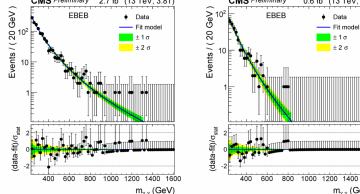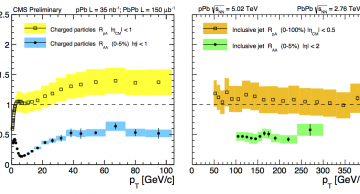12 October 2017
For most of each operational year, the Large Hadron Collider (LHC) typically smashes protons together to generate vast amounts of data for physicists to analyse. These proton-proton (pp) collisions were responsible, for example, for…
News
|
lapka |
Physics
The 10th International workshop on top quark physics, TOP2017, was held in Braga, Portugal, from September 17th to 22nd, 2017 and brought together a number of experimentalists and theorists from all over the world. The CMS Collaboration presented…
|
petrilli |
Physics
Harvesting of the large 13 TeV data set delivered by the LHC in 2016 and collected with the CMS detector continues, with 20 new results to be presented at the EPS 2017 conference, adding to the more than 60 results already presented at the 2017…
|
petrilli |
Physics
The exploitation of the LHC data collected by CMS is continuing successfully, with more than 35 new results presented at the Moriond 2017 conference, most of which used the full 2016 luminosity. These results cover all the research lines of the…
|
cmspeopl |
Physics
The Rencontres de Moriond – Electroweak (Moriond EW) takes place this week in La Thuile, Aosta Valley, Italy, where the CMS Collaboration will present more than 30 new results approved since the December 15 seminar at CERN. First measurements of the…
|
achintya |
Physics
The first phase of collisions following the LHC restart earlier this year has provided CMS with a wealth of data at a new energy frontier of 13 TeV. This centre-of-mass collision energy, the highest ever achieved by a particle accelerator, is…
|
cmspeopl |
Physics
Note: This document is also available in the following languages (PDFs). English | French | Chinese (simplified) | Chinese (traditional) | Croatian | Finnish | German | Hungarian | Italian | Korean | Persian | Polish | Portuguese | Russian | Serbian…
|
achintya |
Physics
CMS Experiment, CERN
13 May 2015 UPDATE 2: The CMS data used in the result below have been analysed together with LHCb's data to obtain a combined result that is now published in Nature. Including all of the data taken by both experiments at 7 and 8…
|
sphicas |
Physics
Among the leading candidates to describe physics beyond the standard model of particle physics is Supersymmetry, a new symmetry that posits the existence of a partner particle for each known particle in the standard model. Supersymmetry, or “SUSY”…
|
campore |
Physics
The data reveal that the particle discovered at CERN continues to behave just like the Standard Model predicts
Since the discovery of a Higgs boson by the CMS and ATLAS Collaborations in 2012, physicists at the LHC have been making intense efforts…
|
mnguyen |
Physics
A few of the results that CMS presented at this year’s Quark Matter conference were highlighted a couple of weeks ago in the CERN Courier article that was also posted on CMS news. That article was posted before the start of the conference, so it did…
|
rolandc |
Physics
This article originally appeared in the CERN Courier on 22 May 2014.
Although the CMS experiment was designed primarily for precise measurements in proton–proton (pp) collisions, in recent years it has demonstrated exceptional capabilities in…









